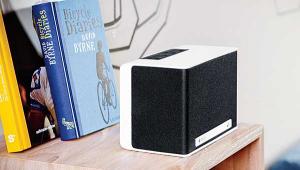Bass-ic Training Page 2
 Beyond aesthetics, placing your subwoofer in a different location than your main satellite speakers provides sonic advantages, as well. For instance, placing your speakers closer to any room boundary (like the floor) augments the low-frequency output by 3 decibels, which is like doubling your amplifier power. Placing the speaker next to two surfaces (like the wall and the floor) will increase output by 6 dB. Add in a corner, and the three surfaces maximize output of bass with a 9-dB boost in level. Middle and upper frequencies, on the other hand, generally sound better when placed away from room surfaces. By separating the upper and lower frequencies, we can put the subwoofer and satellite speakers in locations that achieve the best sound for each type of speaker.
Beyond aesthetics, placing your subwoofer in a different location than your main satellite speakers provides sonic advantages, as well. For instance, placing your speakers closer to any room boundary (like the floor) augments the low-frequency output by 3 decibels, which is like doubling your amplifier power. Placing the speaker next to two surfaces (like the wall and the floor) will increase output by 6 dB. Add in a corner, and the three surfaces maximize output of bass with a 9-dB boost in level. Middle and upper frequencies, on the other hand, generally sound better when placed away from room surfaces. By separating the upper and lower frequencies, we can put the subwoofer and satellite speakers in locations that achieve the best sound for each type of speaker.
 The divorce of low and mid/ upper frequencies results in other very important benefits. First of all, by separating the low frequencies from the main ensemble, you free your midrange driver to concentrate only on midrange frequencies, thus eliminating the distortion that occurs when small drivers try to reproduce extremely low frequencies. Second, in a full-range system, most amplifier power is eaten up by the power demands of low frequencies and large woofers. Adding a separate, dedicated amplifier for the low frequencies not only allows for more bass but leaves more power for your midrange and upper frequencies. More importantly, manufacturers can design amplifiers specifically for a subwoofer's size and application. Early on, there weren't very many active (or self-amplified) subwoofers; fortunately, they've become more common.
The divorce of low and mid/ upper frequencies results in other very important benefits. First of all, by separating the low frequencies from the main ensemble, you free your midrange driver to concentrate only on midrange frequencies, thus eliminating the distortion that occurs when small drivers try to reproduce extremely low frequencies. Second, in a full-range system, most amplifier power is eaten up by the power demands of low frequencies and large woofers. Adding a separate, dedicated amplifier for the low frequencies not only allows for more bass but leaves more power for your midrange and upper frequencies. More importantly, manufacturers can design amplifiers specifically for a subwoofer's size and application. Early on, there weren't very many active (or self-amplified) subwoofers; fortunately, they've become more common.

Before you venture to your nearest home theater dealer, though, you should qualify your needs. To begin with, the size of your room and the volume you listen at are extremely important. If you have a large room or listen at high levels, you'll want a bigger, more-powerful bass box. If you have a small room and don't play the music too loud, you can get by with a smaller subwoofer. In general, 2,000 cubic feet is considered an average-size room. When you're figuring out the size of the theater, it's very important to calculate the total room volume (length by width by height). Of course, vaulted or raised ceilings are going to dramatically affect this sum. Also, if the room opens up to or adjoins another room that cannot be sealed off from the theater, this must be factored in to the total volume.
- Log in or register to post comments






















































